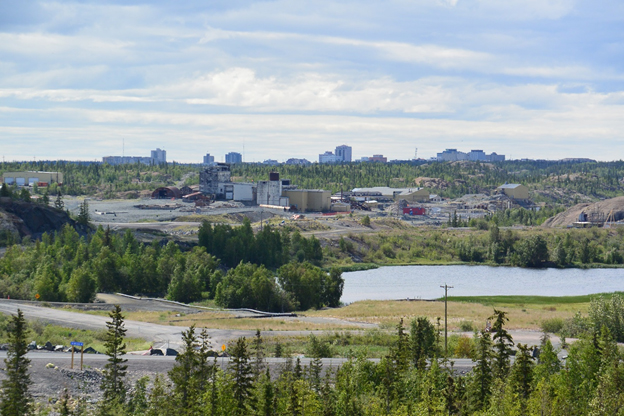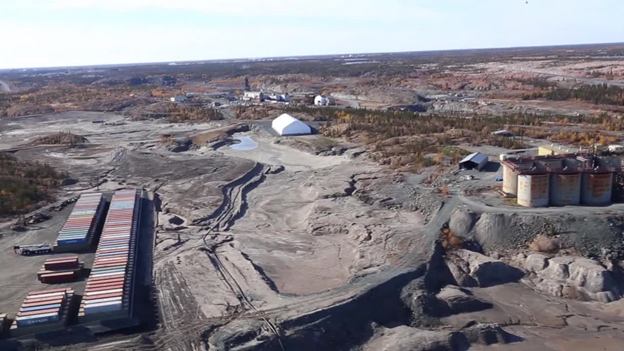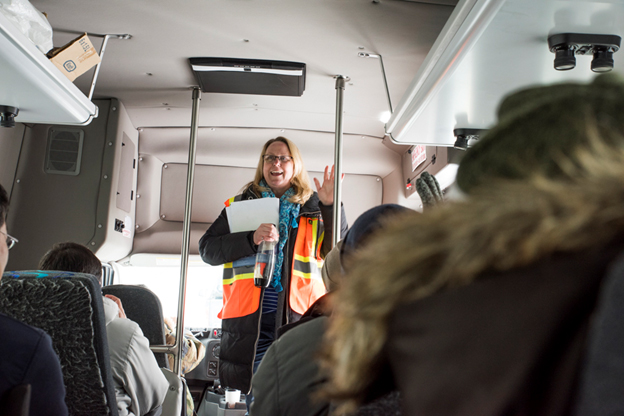Giant Mine newsletter: April 2019
Get the most recent updates on the Giant Mine remediation project.
On this page
Submission of the water licence application package
The Giant Mine Remediation Project formally submitted its application for a type A water licence to the Mackenzie Valley Land and Water Board on April 1, 2019. The Giant Mine Remediation Project team has been working toward resubmitting its application since the environmental assessment was complete in 2014.
The package represents a tremendous amount of work over several years by the project team, community partners, stakeholders, technical experts, and members of the public. The input from the project's numerous engagement activities was carefully considered by the team and, along with input received from partners and affected parties, is reflected in the final Closure and Reclamation Plan and supporting documents. It is a significant milestone for all those who have been involved.
The project team thanks all those who have participated in the numerous engagement activities over the years, for their time and commitment toward helping to develop a robust and effective plan for the remediation of the site.
The water licence process, in brief
Any project in the Mackenzie Valley region that needs to use water or deposit waste has to apply for a water licence, as per the Mackenzie Valley Resource Management Act (MVRMA). The Water licence itself is a document that allows the Land and Water Boards to set conditions for projects around their use of water and deposit of waste. This will include things like how a project manages water, the criteria that has to be met before discharging effluent, and what kind of plans and designs they have to submit to the Board for approval once a licence has been issued.
Different things can trigger the need for a Water Licence, and whether this should be a type A or a type B water licence. The Giant Mine Remediation Project needs a type A water licence, the bigger of the 2, to complete the clean-up work. This is triggered by:
- the amount of water stored on surface behind dams in former tailings ponds prior to remediation
- the estimated amount of water that will be used during remediation activities
- use of water crossings
- alterations to the bed and banks of watercourses as part of remediation activities.

The Mackenzie Valley Land and Water Board is in charge of the Water Licence process for the Giant Mine Remediation Project. Under the authority of the Mackenzie Valley Resource Management Act, they will develop a water licence that is then sent to the Minister for approval. Once a licence is approved by the Minister, the Board reviews and approves all documents required by the licence, throughout the life of the Project.
The Board manages documents through two systems:
- the Mackenzie Valley Land and Water Board Online Review System, where the Project's Water Licence documents are made available for review throughout this process
- the Mackenzie Valley Land and Water Board Public Registry, where the Project's documents related to the Water Licence and Land Use Permit will be permanently posted for public access
When the Project team submitted the application package on April 1, 2019, it officially triggered the formal process with the Land and Water Board. To participate in the initial review period, organizations and members of the public must submit comments to the Board through their Online Review System rather than providing comments to the Project team as was done to develop the application package. Based on the comments received, the Board will set the agenda and topics for the technical sessions and the Public Hearing. The Project team is responsible for responding to reviewer comments and requests throughout the process, and will give presentations on key topics of concern at technical sessions and the Public Hearing.

Organizations and members of the public must also contact the Mackenzie Valley Land and Water Board if they intend to formally participate as Interveners in the public hearing and comment on the proposed water licence.
However, you don't have to be a registered Intervener to attend the public hearing or speak during this session, as there will be time set aside for members of the public to speak in front of the project team and the board. The Mackenzie Valley Land and Water Board is best positioned to answer questions about the water licence regulatory process.
The water licence is not the only regulatory authorization the Project will require. The Project team has also submitted an application to the Mackenzie Valley Land and Water Board for a land use permit. The permitting process for the land use permit will be aligned with the water licence process. Other authorizations the project will need to apply for include:
- a development permit through the City of Yellowknife
- a quarry permit through the Government of the Northwest Territories
- Fisheries Authorizations for work in fish bearing streams through Fisheries and Oceans Canada
The project team will work toward applying for the permits and authorizations required to start remediation concurrently with the water licence process, to create more efficient information-sharing between applications.
Site update

The Giant Mine Remediation Project team has kicked off additional investigative drilling on the tailings area and the dams. The drilling will help the Project team confirm how deep the tailings ponds are as well as confirm the make up of the tailings and the tailings dams. This work is being done to help confirm the project team's design plans for the tailings areas. The project expects to drill approximately 60 holes in total. This work is expected to take continue into Spring 2019.
As active work has started on site, the Project team has also resumed air quality monitoring at the site perimeter. Activity-specific air quality monitoring has also begun around the areas where drilling is occurring. The community stations monitor air quality year-round.
Engagement and outreach update
In March, the Giant Mine Remediation Project team held the annual community forums for the Yellowknives Dene First Nation, the North Slave Métis Alliance, and the Yellowknife-area public. The team would like to thank everyone who came out to learn about work on the site in the past year and plans going forward, as well as the upcoming Water Licence application process.
The team also made its virtual reality tour of the site available for the public to try out while the technology was in town for the public forum. Those who stopped by were able to get context of the size of the site as well as see what the site might look like after remediation, as envisioned by the engineers' designs.
The Giant Mine Remediation Project also remains of interest to legislative interns visiting the Northwest Territories. This year, both the Manitoba Legislature and the Ontario Legislature Internship Programme's have made learning about the Giant Mine's history and coming remediation of the site part of their visits to the territory. Senior Communications Officer Myranda Bolstad presented to Manitoba's 6 visiting interns in October 2018, and then to a larger group of 12 interns visiting from Ontario Legislature in February 2019.
On March 15, as part of its annual professional development symposium, the Northwest Territories and Nunavut Professional Engineers and Geoscientists (NAPEG) asked to learn more about the Giant Mine Remediation Project. NAPEG licenses and regulates professional engineers and geoscientists, as well as their firms that practice in the two territories. Deputy Director Natalie Plato, a professional engineer, presented to the group of participants, as well as conducted 2 surface tours of the site.

